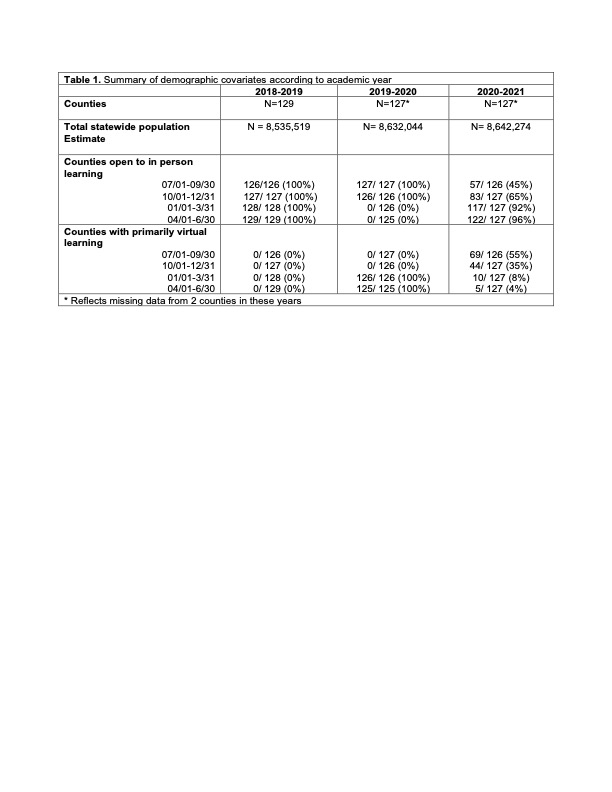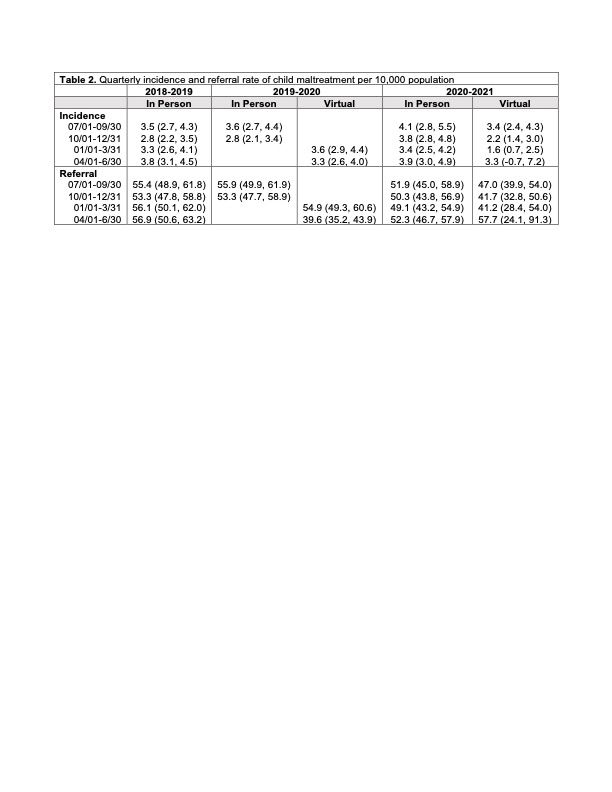Child Abuse & Neglect
Child Abuse & Neglect 1
602 - The Association between Duration of School Closure and the Reporting and Incidence of Child Maltreatment
Friday, April 28, 2023
5:15 PM - 7:15 PM ET
Poster Number: 602
Publication Number: 602.103
Publication Number: 602.103
Elizabeth Wolf, Virginia Commonwealth University School of Medicine, Richmond, VA, United States; My Nguyen, Virginia Commonwealth University School of Medicine, Richmond, VA, United States; Roy T. Sabo, Virginia Commonwealth University School of Medicine, Richmond, VA, United States; Robin L. Foster, Children's Hospital of Richmond, Henrico, VA, United States; Jennifer L. Gilbert, Virginia Commonwealth University School of Medicine, Richmond, VA, United States; Casey Freymiller, Virginia Commonwealth University School of Medicine, Richmond, VA, United States; Bergen B. Nelson, Children's Hospital of Richmond at VCU, Richmond, VA, United States; Alex H. Krist, Virginia Commonwealth University, Fairfax, VA, United States

Elizabeth R. Wolf, MD, MPH (she/her/hers)
Assistant Professor of Pediatrics
Virginia Commonwealth University School of Medicine
Richmond, Virginia, United States
Presenting Author(s)
Background: The duration of school closure due to the COVID-19 pandemic varied substantially by county. It is not yet known how the duration of closure impacted the reporting and incidence of child maltreatment.
Objective: To determine if in-person vs. virtual schooling was associated with differences in reporting and incidence of child maltreatment.
Design/Methods: Using data from the Virginia Department of Education, we recorded the opening date of public schools to children kindergarten through 12th grade at least 2 days a week. We recorded the number of quarterly referrals and founded cases of child maltreatment (0-18 years of age) from the Virginia Department of Social Services (DSS) from July 2018 to June 2021 standardized to 10,000 persons. Schools were considered “open” if the opening date occurred during or before that quarter. To control for county-level differences, we used linear mixed methods to study the association of referral and incidence rates between in-person vs. virtual schooling status between the same quarters in 2018-2019 and 2020-2021 academic years.
Results: We found that there were significantly lower referral rates in spring 2020 when all schools were closed (39.6 per 10,000 [95%CI: 35.2-43.9]) compared to spring 2019 (56.9 per 10,000 [95%CI: 50.6-63.2]) when all schools were open. In contrast, there was no significant difference in the number of founded cases in spring 2020 (3.3 per 10,000 [95%CI:2.6-4.0]) compared to spring 2019 (3.8 per 10,000 [95% CI:3.1-4.5]). In the 2020-2021 academic year, there tended to be more referrals in counties with in-person learning (50.8 per 10,000 [95% CI 47.8-53.9]) compared with counties with virtual learning (45.1 per 10,000 [95% CI: 40.1-50.1]) while there tended to be fewer founded cases in counties with in-person learning (2.8 per 10,000 [95%CI: 2.2-3.4]) compared to counties with virtual learning (3.8 per 10,000 [95%CI: 3.3-4.2]) though these differences did not reach statistical significance. When employing a linear mixed-methods approach comparing 2018-2019 to 2020-2021, there were no statistically significant differences in referral or incidence rates between counties with in-person and virtual learning.
Conclusion(s): Although referrals tended to be higher and incidence lower in counties with in-person learning, we found no significant difference between learning types when we compared counties to themselves in pre-COVID periods. This suggests that referral and incidence rates of child maltreatment are driven primarily by underlying differences in counties rather than the type of schooling children receive.


